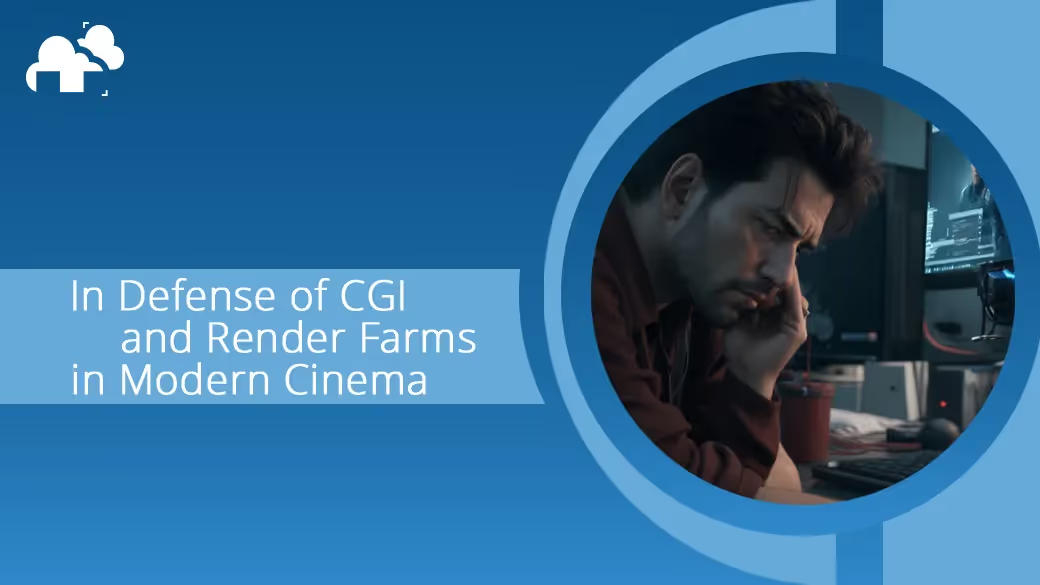
In recent times, there has been a growing chorus of voices lamenting the perceived overuse of CGI (computer-generated imagery) in films. Some critics point fingers at CGI- in some cases the artists and studios that create it, as the culprits enabling this trend. By extension, render farms - online services that provide accessible computing power to create CGI graphics can also be said to be at fault. But is it fair to blame the artists or even render farms for the excessive and careless use of CGI in some modern blockbusters? Let's delve deeper into this nuanced issue.
Render farms have undoubtedly revolutionized the world of filmmaking and animation. What was once only possible in the exclusive domain of big studios with massive budgets is now accessible to aspiring indie filmmakers and small production houses. This democratization of technology has led to a welcome surge in creativity, allowing more artists and directors to bring their imaginative visions to life on screen.
Render farms are online networks of thousands of high-powered servers and GPUs. By tapping into these resources, artists can render complex 3D scenes and effects far more quickly than with a single in-house machine. The time and cost savings provided by render farms have blown open the doors for studios of all sizes to create incredibly detailed and realistic CGI.
Of course, state-of-the-art CGI does not come cheap even with online render farm services. However, the pay-as-you-go model provides flexibility, especially for smaller players. If used judiciously, render farms provide a pathway for emerging talent with limited budgets to craft CG visuals that can rival big-budget productions.
When criticizing the overuse of CGI in cinema, it's crucial to make a distinction between the technology itself and the artist wielding it. CGI is a tool, albeit an incredibly powerful one. Just as a paintbrush in unskilled hands can only produce a mediocre painting while a master can create magic, the results of CGI ultimately depend on the vision and discretion of the filmmaker, since ultimately the artists that work behind the scenes act in accordance with the filmmaker’s planning and priorities.
In the hands of a virtuoso director, CGI can enable breathtaking spectacle, fantastical worlds, and emotional power. In careless or commercially-driven hands, it can be used to paper over weak storytelling or as a crutch for lack of skill and creativity. The technology itself is neutral - it's all about how it is applied.

If we are witnessing an over-reliance on superficial, subpar CGI in some modern blockbusters, the root causes have more to do with current market dynamics and studio pressures than the existence of render farms per se. Several interlinked factors are likely at play:
There is clearly a sizable audience demand and appetite for massive, visual effects-driven spectacles, especially in lucrative genres like sci-fi, fantasy, and superhero movies. Financial incentives lead studios to prioritize CGI-fueled extravagance over nuanced storytelling.
The constant pressure on major studios to churn out sequels and tentpole releases on brutally tight schedules can encourage an over-reliance on CGI. It's often faster to digitally render a backdrop or scene than to deal with the logistics of shooting on location or building intricate practical sets.
Paradoxically, despite the costs involved, for some productions, CGI may actually be a cheaper route than practical effects, elaborate sets, on-site filming, etc. This can skew incentives towards CGI, especially for smaller studios lacking the deep pockets of major players.
With CGI making literally anything visually possible, some directors seem to get carried away without sufficient taste or artistic discernment about when/how to deploy it. Greater wisdom and judiciousness are called for.
When CGI is used to elegantly enhance a story rather than as a crutch for mediocrity, it can take cinema to unprecedented levels.
While CGI has undoubtedly been misused and overused in some modern blockbusters, at its best it can help elevate filmmaking to extraordinary new heights. When applied with discernment and artistry, CGI provides tools to realize spectacular worlds, characters, and stories that would be impossible through practical effects and filming alone.
Films like Avatar, Life of Pi, and Gravity demonstrate the immense potential of CGI to bring to life fictional realms and situations that audiences could previously only dream of. The alien world of Pandora in Avatar is so intricately detailed and fully realized, that it feels totally authentic and lived-in rather than an artificial CGI set-piece. Life of Pi manages to make viewers deeply care about and connect with a CGI tiger character. Gravity uses stellar effects to evoke the terrifying vastness of space and the utter isolation of floating untethered far from Earth.
Rather than using CGI as a crutch, these films integrate it with a strong overall vision and storytelling. The imagery serves the narrative rather than overpowering it. CGI amplifies the emotional impact rather than detracting through a hollow spectacle. In skilled hands, CGI can be poetry in motion, allowing filmmakers to tap into potent new realms of aesthetic beauty and story possibilities.
Rather than scapegoating render farms for enabling CGI excess, the better critical approach is balance and nuance. We should champion films that use CGI judiciously to complement great storytelling, while constructively critiquing those that use effects as a glossy cover for mediocrity.
Render farms have democratized access to sophisticated CGI tools, unleashing new waves of creativity. But as with any art form, realizing the full potential requires taste, discernment and skill on the part of the artist. If some studios are wielding the tools poorly, the blame lies with imperfect human judgment, not the tools themselves.
Rather than reject CGI wholesale, we should cultivate a film culture that honors substance as much as style and values practical methods alongside CGI. After all, in the right directorial hands, CGI can help create unprecedented cinematic magic and wonderment that practical effects alone cannot. The path forward is thoughtful integration and balance, not throwing the CGI baby out with the bathwater.